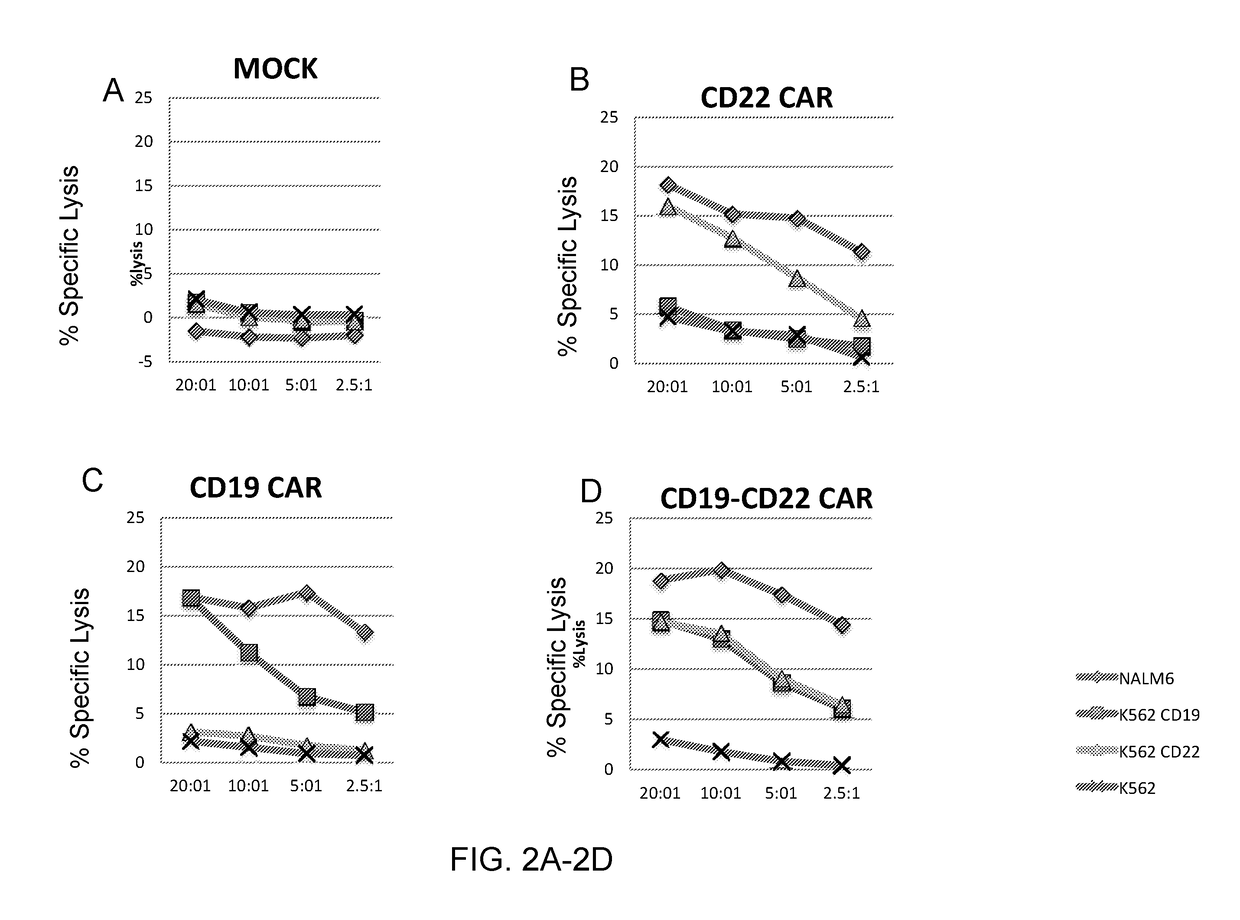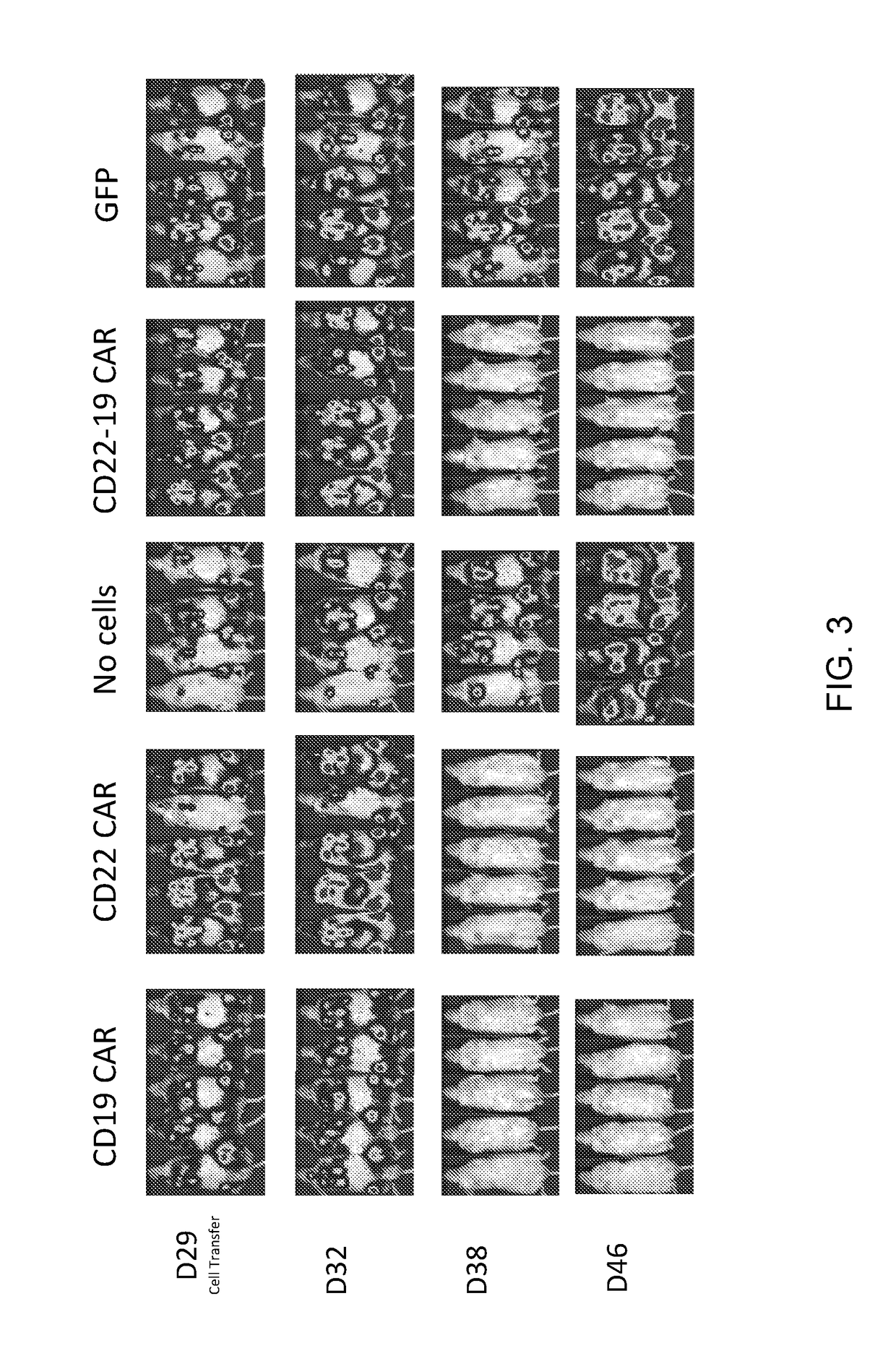Dual specific Anti-cd22-Anti-cd19 chimeric antigen receptors
a chimeric antigen receptor and dual specific technology, applied in the direction of instruments, drug compositions, peptides, etc., can solve the problems of poor prognosis of many cancers, including hematological malignancies, and achieve the effect of reducing tumor burden
- Summary
- Abstract
- Description
- Claims
- Application Information
AI Technical Summary
Benefits of technology
Problems solved by technology
Method used
Image
Examples
example 1
[0095]This example demonstrates the expression of dual specific anti-CD19-anti CD22 CARs by human T cells.
[0096]Human T cells were transduced with a lentiviral vector encoding a dual specific anti-CD19-anti CD22 CAR comprising the amino acid sequence of SEQ ID NO: 29 or a retroviral vector encoding a dual specific anti-CD19-anti CD22 CAR comprising the amino acid sequence of SEQ ID NO: 30. As controls, human T cells were not transduced (mock-treated cells) or were transduced with a vector encoding a CAR having antigenic specificity for only CD19 (anti-CD19 CAR) or a CAR having antigenic specificity for only CD22 (anti-CD22 CAR) (see FIG. 5).
[0097]CAR expression by CD3+ cells was evaluated by flow cytometry. Expression of the anti-CD19 CAR was detected using an anti-CD19 idiotype antibody, and expression of the anti-CD22 CAR was detected using a CD22 Fc construct. No expression of anti-CD19 CAR or anti-CD22 CAR was detected in the mock-treated cells. Expression of the anti-CD19 CAR, ...
example 2
[0099]This example demonstrates that human cells transduced with a vector encoding a dual specific anti-CD19-anti CD22 CAR produce cytokine upon co-culture with CD19+ / CD22+, CD19− / CD22+, or CD19+ / CD22− target cells.
[0100]Human T cells were transduced with a lentiviral vector encoding an anti-CD19 CAR, green fluorescent protein (GFP), or a dual specific anti-CD19-anti CD22 CAR (SEQ ID NO: 29) (see FIG. 5). Tranduced cells were incubated with the target cells listed in Table 3 below for 12 hours. The supernatants were assayed for interferon (IFN)-gamma (γ) secretion by enzyme-linked immunosorbent assay (ELISA).
TABLE 3Target CellPhenotypeK562CD19− / CD22−K562CD19CD19+ / CD22−K562CD22C2CD19− / CD22+K562CD22C4CD19− / CD22+NALM6 (B ALL cell line)CD19+ / CD22+REH (B ALL cell line)CD19+ / CD22+
[0101]The results are shown in FIG. 1. As shown in FIG. 1, human cells transduced with a vector encoding the dual specific anti-CD19-anti CD22 CAR (SEQ ID NO: 29) produced cytokine upon co-culture with CD19+ / CD22...
example 3
[0102]This example demonstrates that human cells transduced with a vector encoding a dual specific anti-CD19-anti CD22 CAR lyse CD19+ / CD22+, CD19− / CD22+, or CD19+ / CD22− target cells in vitro.
[0103]Human T cells were untransduced (mock) or were transduced with a lentiviral vector encoding an anti-CD19 CAR, an anti-CD22 CAR, or a dual specific anti-CD19-anti CD22 CAR (SEQ ID NO: 30) (see FIG. 5). The transduced cells were incubated with Cr51-labeled target cells NALM6, K562, K562CD19, or K562CD22 (CD19− / CD22+) for four hours. Target cell killing was measured by chromium release assay. The results are shown in FIGS. 2A-2D.
[0104]As shown in FIGS. 2A-2D, human cells transduced with a vector encoding the dual specific anti-CD19-anti CD22 CAR (SEQ ID NO: 30) specifically lysed CD19+ / CD22+, CD19− / CD22+, or CD19+ / CD22− target cells in vitro as measured by chromium release assay.
PUM
| Property | Measurement | Unit |
|---|---|---|
| temperatures | aaaaa | aaaaa |
| time | aaaaa | aaaaa |
| nucleic acid | aaaaa | aaaaa |
Abstract
Description
Claims
Application Information
 Login to View More
Login to View More - R&D
- Intellectual Property
- Life Sciences
- Materials
- Tech Scout
- Unparalleled Data Quality
- Higher Quality Content
- 60% Fewer Hallucinations
Browse by: Latest US Patents, China's latest patents, Technical Efficacy Thesaurus, Application Domain, Technology Topic, Popular Technical Reports.
© 2025 PatSnap. All rights reserved.Legal|Privacy policy|Modern Slavery Act Transparency Statement|Sitemap|About US| Contact US: help@patsnap.com



